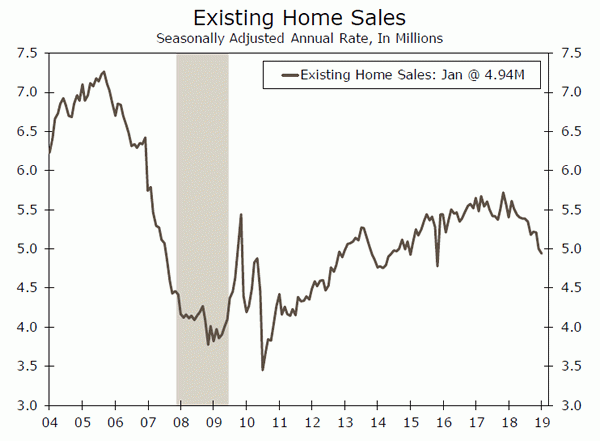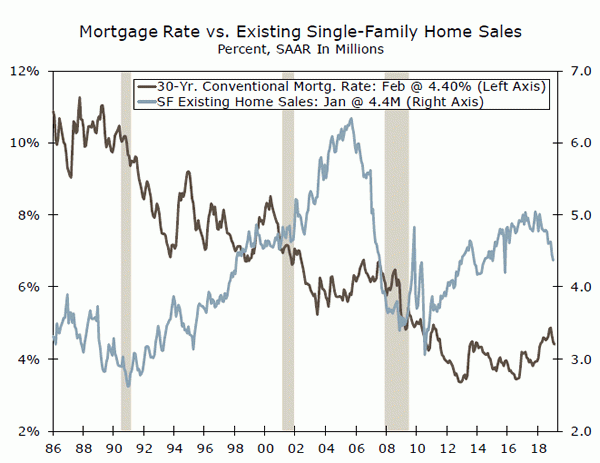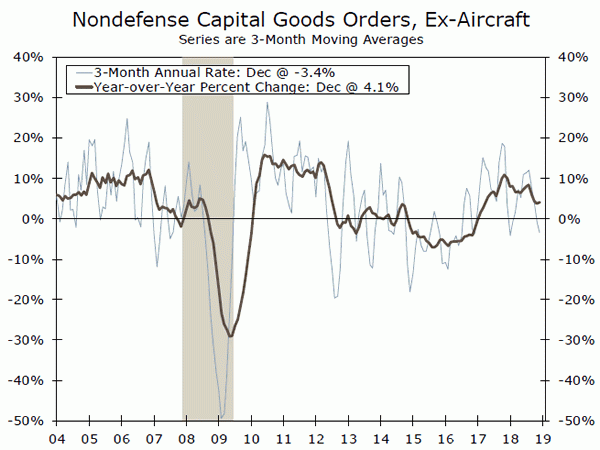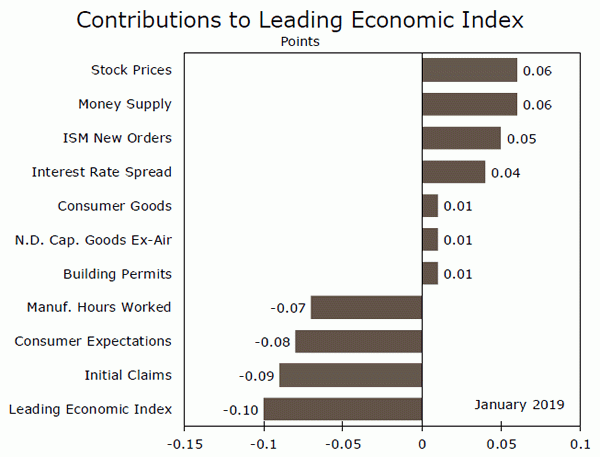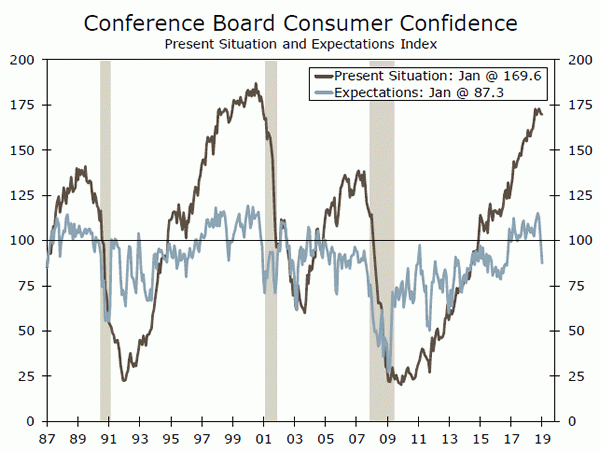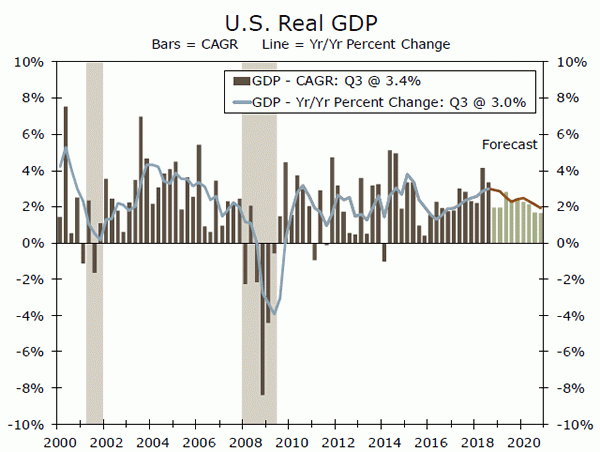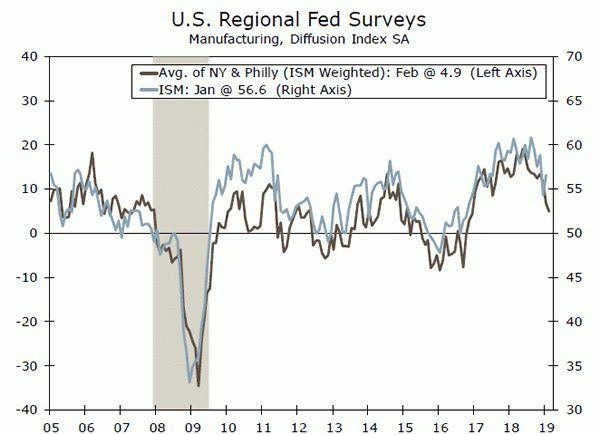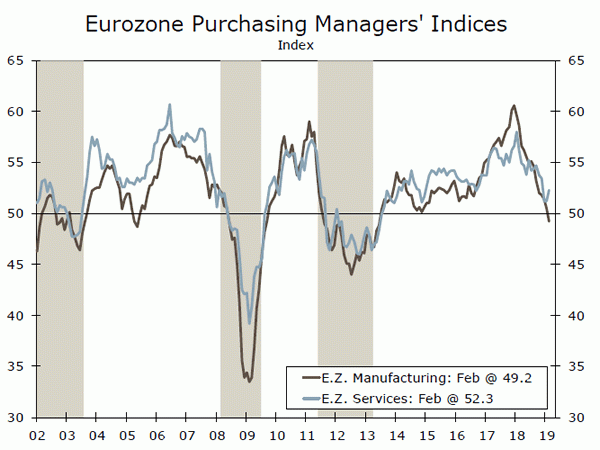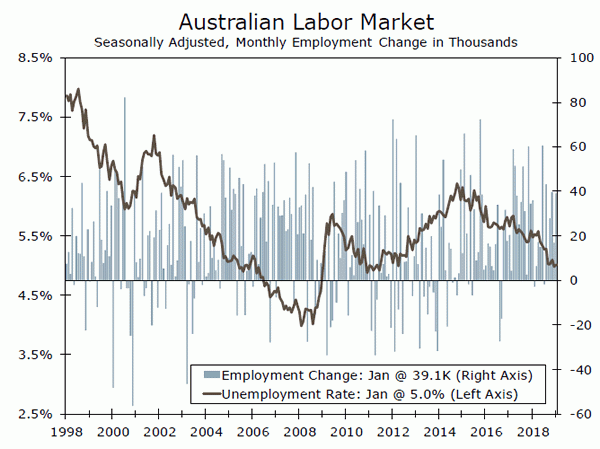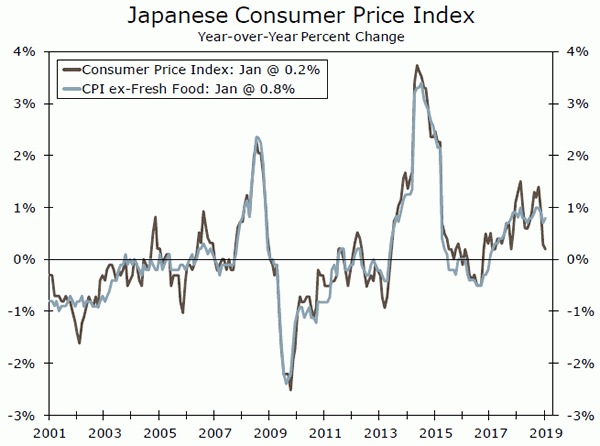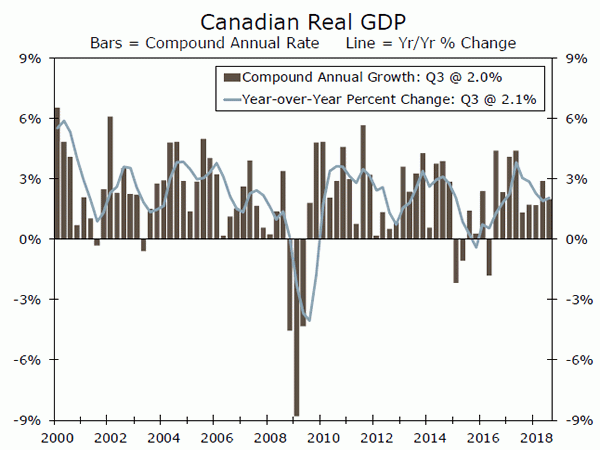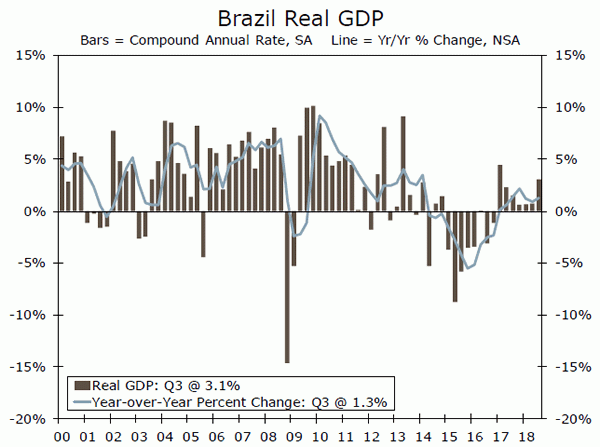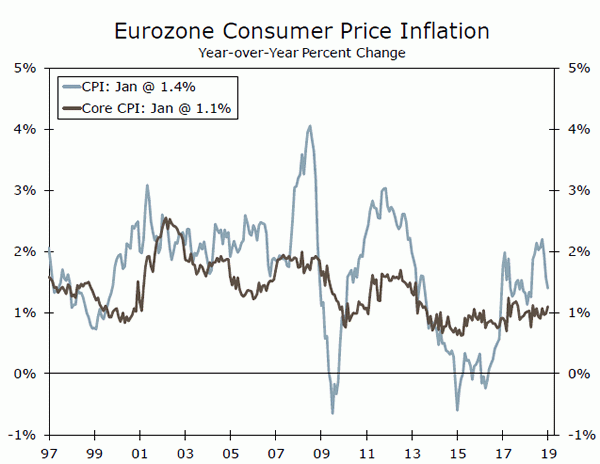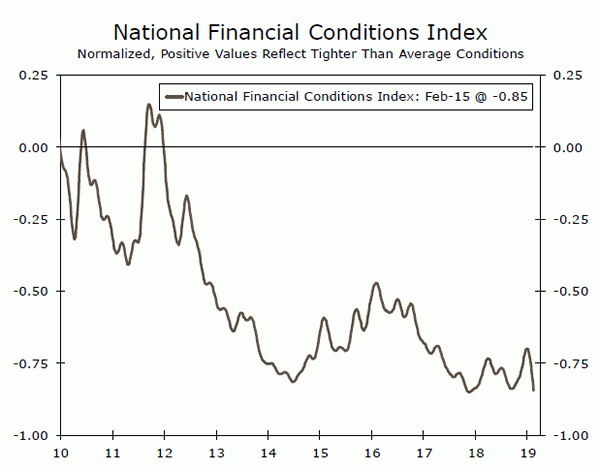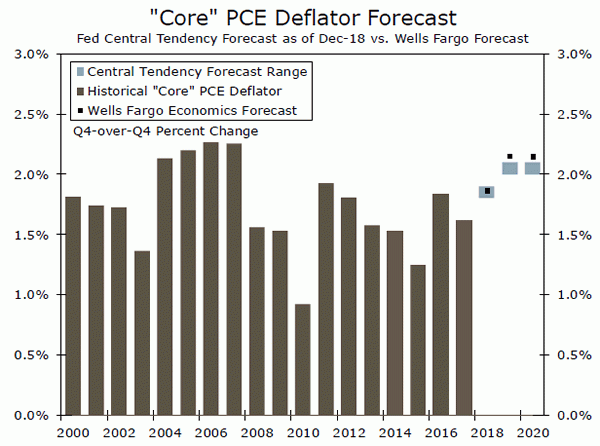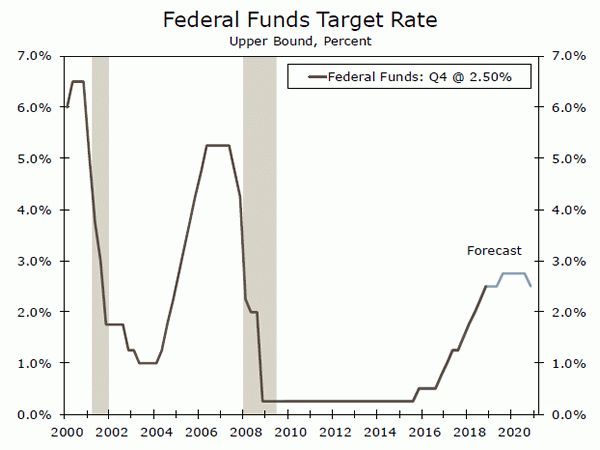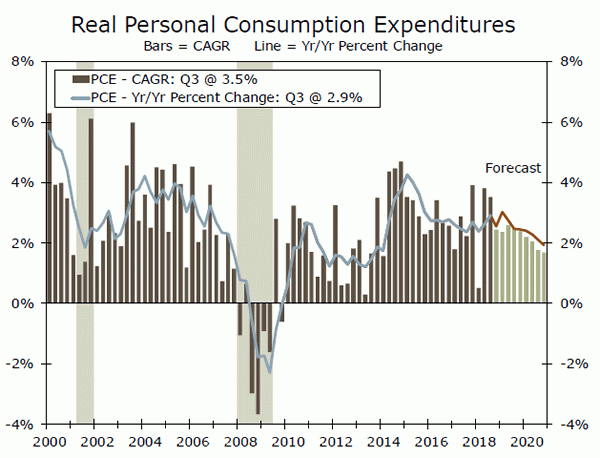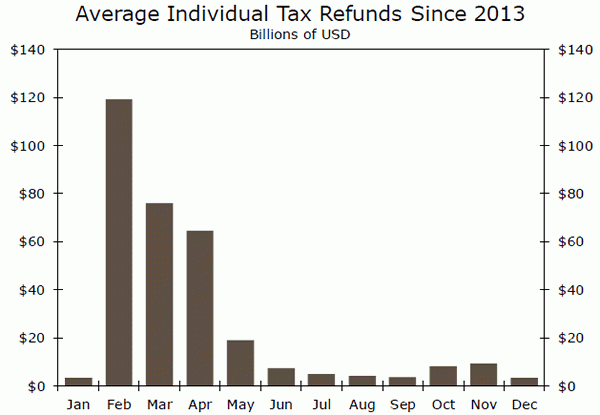U.S. Review
Signs Point to More Moderate Economic Growth Ahead
- Existing home sales dropped 1.2% in January, reflecting continued housing market weakness.
- The NAHB Housing Market Index rose to 62 in February, as more builders expressed confidence on lower mortgage rates.
- Durable goods orders increased 1.2% in December. Core orders fell 0.7%, indicating that business investment will likely slow.
- FOMC minutes for the January 29-30 meeting were released and revealed a consensus among members that patience should be exercised with further rate hikes. Many members also appeared ready for the end of the balance sheet run-off.
Signs Point to More Moderate Economic Growth Ahead
Data for 2019 are still somewhat limited, but several signs point to a moderate slowdown in overall economic growth relative to the strong pace registered throughout 2018. The weakness in the housing market felt through much of last year has extended into 2019. Existing home sales dropped 1.2% in January, as the lingering effects of rapid home price appreciation and higher mortgage rates in the second half of 2018 dampened sales for the third consecutive month. While overall sales have slumped, lower mortgage rates more recently make us optimistic that gradual improvements in home sales should be forthcoming.
A similar sentiment was expressed by homebuilders in the NAHB Housing Market Index, which posted its second consecutive monthly gain in February after dramatically falling in the final month of 2018. More builders feel confident about future market conditions given the lower rates, which bodes well for new residential construction headed into the spring. Mortgage applications also improved to start the year. The MBA Mortgage Applications Purchase Index rose 1.7% for the week ending February 15. While extremely volatile on a weekly basis, the average index reading seven weeks into 2019 is 3.1% higher than the same period last year.
Meanwhile, durable goods orders rose in December. Overall orders increased 1.2% during the month, while shipments for core capital goods edged 0.5% higher. However, much of December’s gain was due to a 28.4% surge in nondefense aircraft orders. Core capital goods orders, which is an important barometer of future business investment, slipped for the second straight month and fell 0.7%. We still expect business investment to rise and be supportive of overall GDP growth in Q4; however, the drop in core orders makes the prospect of continued growth at its current pace unlikely.
The leading economic index (LEI) continues to point to generally favorable economic conditions in coming months. The 0.1% decline registered in January was weighed down by a drop in average consumer expectations, likely a fallout from the partial federal government shutdown and stock market volatility towards the end of 2018. The government closure also led to an uptick in jobless claims, which were also a drag on the topline index. More recent data, however, revealed that the spike in claims was temporary. Initial jobless claims fell 23,000 to 216,000 for the week ending February 16, underscoring just how resilient the labor market is at present.
The topic of a strong labor market was also breached in the minutes for the most recent January 29-30 FOMC meeting released this week. While no change was made to the target federal funds rate during the meeting, the minutes revealed that participants generally agreed that patience should be exercised in the face of tighter financial conditions and moderating global economic growth. We still believe that the FOMC is not entirely finished with rate hikes, and modest price pressures and sturdy employment growth should lead to another hike toward the end of the year. Furthermore, the minutes appear to confirm our view that the balance sheet runoff will likely come to an end by the end of 2019 or early 2020.
U.S. Outlook
Consumer Confidence Index • Tuesday
A partial government shutdown rung in the new year, trade “discussions” between the United States and China to prevent a fullblown trade war remain ongoing and financial markets have recovered but remain suppressed from all-time highs seen only a few short months ago. Such market noise has inevitably found its way into the confidence of consumers. The Consumer Confidence Index has declined the past three months, with most of the weakness concentrated in the expectations component.
We expect a modest rebound in confidence this month. If confidence falls short of our expectation, it will be the latest affirmation that a slowdown in consumer spending is in store this year. A miss to the upside, however, would suggest that the still-strong job market and the modest gain in wages that has finally begun to transpire have provided some much needed support to the outlook of consumers.
Previous: 120.2 Wells Fargo: 124.0 Consensus: 124.2
Q4 GDP • Thursday
On Thursday, market participants’ attention will turn to Q4 GDP. Given that it has been more than a month since the originally scheduled release date, the Census Bureau has decided this will be a combined release of the first and second estimates of Q4 growth.
Recent data have pointed to a slower-than-anticipated pace of growth in the final months of the year. As such, we have reduced our Q4 GDP growth forecast to 2.0% from 2.3% previously. Consumption growth is likely to be weak, as retail sales plummeted 1.2% in December (the largest one-month decline since 2009). However, as we noted, it was hard to square the plunge in sales with other variables, which suggests revisions may eventually be in order. Business fixed investment, on the other hand, may surprise to the upside. The advance estimate of durable goods data for December revealed a rise in capital goods shipments, which bodes well for Q4 investment spending.
Previous: 3.4% Wells Fargo: 2.0% Consensus: 2.5% (Quarter-over-Quarter, Annualized)
ISM Manufacturing Index • Friday
With durable goods data having been delayed in recent months, the ISM manufacturing index has received particular emphasis as an indication of how the factory sector is faring.
The ISM manufacturing index rose 2.3 points in January. However, that rebound occurred after the index posted its single-largest monthly drop since December 2008. Underlying details of January’s report and slower domestic and global growth continue to point to factory activity slowing on trend this year.
Consistent with what we have seen from the regional PMIs to date, we expect the ISM index to give up a bit of ground in February. If the index falls more than we anticipate, it would support the cautious policy stance by the FOMC. A miss to the upside, however, would provide some comfort that activity in the factory sector has held up, at least, through February.
Previous: 56.6 Wells Fargo: 55.0 Consensus: 56.0
Global Review
Still Quiet on the Global Central Bank Front
- The global economic data released this week have been decidedly mixed. In the Eurozone service sector confidence improved, but manufacturing confidence fell into contraction territory. Australian employment figures were sturdy, but other data were mostly soft in tone. Finally, in Japan, the economic figures over the past five days have been generally subdued.
- Given this mixed backdrop, things should remain quiet on the global central bank front for now. Central bank comments from Europe and Japan have been mostly dovish in recent weeks, while Australia has adopted a more balanced outlook. It could still be some time before these central banks adjust policy rates.
All We Need Is Just a Little Patience
The Eurozone February manufacturing and service sector PMIs provided the latest reading on the state of the region’s economy. Those figures hardly offered a silver lining, although perhaps made the economic clouds a little less dark. On the negative side, the manufacturing PMI fell to 49.2, the first time that index has been in contraction territory since mid-2013. That largely confirms softness seen in other indicators, including a large decline in December industrial production. On a more positive note the service PMI rose to 52.3, the first increase since September, meaning that the economy-wide composite PMI also rose in February. Germany’s economy has been weak in recent quarters, and the fall in the February IFO business confidence to 98.5 hints at continued subdued growth. Overall, with growth sluggish and several European Central Bank policymakers adopting a more dovish tone in recent speeches, we do not anticipate the central bank will begin raising its deposit rate from the current -0.40% until the final quarter of this year.
Reserve Bank of Australia on Hold
While there have pockets of strength in some Australian data, the Reserve Bank of Australia (RBA) is also likely to be on hold for an extended period. January labor market figures were sturdy, with employment rising 39,100, led by a 65,400 gain in full-time jobs, while the unemployment rate was steady at 5.0%. Still, the early February PMI readings showed softness, while wage growth remains moderate, as the Q4 Wage Price Index rose 2.3% year-over-year. Australian economic sentiment was also hurt to some extent by news reports that China had banned imports of Australian coal indefinitely at five key ports. Despite the encouraging employment news the RBA remains firmly on hold for now. Earlier this month the central bank moved to a neutral outlook, with Governor Lowe saying that the probability of the next interest rate move being up or down was more evenly balanced, a view he reiterated at Parliamentary testimony this week.
Bank of Japan Sounds Dovish
Bank of Japan Governor Kuroda also spoke to Parliament this week, telling Japanese lawmakers the central bank may consider additional monetary easing if moves in the yen were to affect the economy and inflation. Kuroda’s comments were largely supported by this raft of economic data. The January CPI rose just 0.2% year-over-year while the core CPI rose 0.8%–both well short of the Bank of Japan’s medium-term inflation goal of 2%. Meanwhile, activity data were broadly soft in tone, as the December all industry activity index fell 0.4% month-over-month and core private sector machinery orders dipped 0.1%. Japan’s manufacturing PMI also fell in February. Given the central bank’s recent comments and the subdued overall tone of the economic figures, there is a risk that the window closes on our base case of a modest adjustment towards less accommodative monetary policy by the Bank of Japan in Q2, a policy adjustment that would be far enough in advance of Japan’s consumption tax increase scheduled to take place in Q4-2019.
Global Outlook
Canada GDP • Tuesday
Canada’s Q4 GDP is due next week, with the slower growth of Q3 expected to continue into Q4. Canada’s economy rose at just a 2.0% annualized rate in Q3, and monthly data hint at subdued growth in the final quarter of 2018. Retail sales excluding motor vehicles recorded five straight monthly declines through December, while manufacturing shipments fell in each month during Q4. Meanwhile, oil production cuts in Alberta likely also weighed on growth during the quarter. We forecast that Canada’s Q4 GDP slowed further to just 1.5% annualized, although given the recent rebound in oil prices and a lessening drag from the Alberta production cuts, we expect growth to improve on a sequential basis as 2019 progresses.
Next week also sees the release of January CPI inflation data. The consensus expects the headline CPI to rise just 1.5% year-over-year, which would be the smallest gain since October 2017, while core inflation measures should be broadly steady just below 2.0%.
Previous: 2.0% Wells Fargo: 1.5% Consensus: 1.5% (Quarter-over-Quarter, Annualized)
Brazil GDP • Thursday
Brazil’s Q4 GDP should show an economic expansion that remains somewhat uneven but on an overall upswing. After GDP rose 0.8% quarter-over-quarter in Q3, the consensus expects sequential growth slowed in Q4. Monthly retail sales data suggest consumer spending was relatively solid last quarter, although weakness in industrial production hints at possible weakness in investment spending. On a year-over-year basis, growth is expected to quicken further, though, to 2.0%. Overall, we expect Brazil’s economic growth to remain moderate over the medium-term. That outlook depends critically on whether President Bolsanaro can successfully push through pension reforms, successful passage of which would likely limit the pace of growth but improve the sustainability of economic expansion.
India’s Q4 GDP is due and is expected to slow to 6.7% year-over-year, while next week other key emerging market data include China’s February manufacturing and services PMIs.
Previous: 1.3% Consensus: 1.5% (Year-over-Year)
Eurozone CPI • Friday
The latest reading on Eurozone inflation is released next Friday, although we do not expect those figures to shift the Eurozone’s monetary policy outlook. We forecast the headline CPI rose 1.5% year-over-year in February, slightly more than the January increase. Moreover, there is arguably some upside rise to that outlook, given a rise in oil prices through much of February, and a relatively stable euro versus the U.S. dollar. That said, underlying inflation pressures are building only gradually, and we forecast the core CPI to rise 1.1% year-over-year in February, the same as the previous month and well short of the ECB’s inflation goal.
With economic growth still relatively subdued and inflation pressures building only gradually, we still expect it will be some time before the ECB begins to raise interest rates. Eurozone February economic confidence is also released, with the consensus forecasting the index to ease to 106.0.
Previous: 1.4% Wells Fargo: 1.5% Consensus: 1.5% (Year-over-Year)
Point of View
Interest Rate Watch
The Markets Matter
Minutes from the FOMC’s January meeting offered insight into the reasons for the committee’s abrupt pivot from December to a decidedly more dovish policy stance. As Chair Powell laid out in the post-meeting press conference, the committee viewed the downside risks to growth had increased. Specifically, members were concerned about a slowdown in global growth, waning fiscal stimulus, trade policy tensions and tightening financial conditions.
Tighter financial conditions in the immediate wake of the December meeting came as markets viewed the FOMC as “insufficiently flexible” in its policy path, given the perceived risks to the outlook. Although not wanting to appear beholden to markets, it nonetheless looks like the FOMC’s about-face was determined to demonstrate flexibility.
Of course, policy adjustments are not warranted only when conditions or risks are perceived to have worsened. Since the start of the year, financial conditions have loosened and are now the easiest levels in more than a year (top chart), while equity markets are up about 10% since the December meeting. The improvements come as markets no longer expect the Fed to hike rates further this cycle.
The minutes were not definitive in that view, however. The base case for growth appears little changed. Therefore, if the downside risks subside, “many” participants believe the “patient” stance would need to be revisited.
Evenly Split…For Now
The majority of the FOMC was not clear which way the FOMC’s next move would be. “Several” expected it would be appropriate for at least one more hike this year, while another “several” thought hikes would only be necessary if inflation came in higher than expected. We anticipate inflation will be roughly two-tenths stronger by Q4 what the most recently published FOMC estimates (middle chart), which, along with recent easing in financial conditions, results in one more hike this year (bottom chart). The FOMC may indeed be flexible, but just not in the way the market currently expects.
Credit Market Insights
Canary in the Camry?
Seven million Americans are seriously delinquent on their auto loans, according to the New York Fed. The current number of borrowers 90 days behind on their auto loan payments vastly exceeds the maximum reached in the height of the last recession. With wage growth picking up and job growth still incredibly strong, is this a harbinger of widespread financial distress or something more benign?
Due to the centrality of cars to the economic and personal stability of so many, consumers typically prioritize auto loan payments over other liabilities—even mortgage or credit card debt. Thus, a growing number of consumers transitioning into delinquency on their auto loans can be an indicator of significant financial distress. Yet, this alarming number of delinquent borrowers is to a large extent simply a consequence of an increase in the magnitude of the auto loan market. Lenders originated a record $584 billion of auto loans in 2018, increasingly to prime borrowers, who still comprise a much larger share of outstanding debt than subprime borrowers. The portion of vehicle purchases financed by debt has remained stable, and the flow into serious delinquency in Q4 only reached 2.4%. Still, this marks a noticeable deterioration in performance—this is up from the 2012 cycle low of 1.5%, and is concentrated among the young and the subprime. While the headline of seven million may not indicate a systematic threat, it can offer clues into where financial hardship is the most acute.
Topic of the Week
Refund Status: Still Processing
The tax cuts passed in the final days of 2017 resulted in increased after-tax income for most U.S. households. However, due to a number of factors (changes in withholdings, and the government shutdown) there remains considerable uncertainty about how much of that gain was realized in calendar year 2018 and how much will (or will not) be realized during the 2019 filing season.
What is known: so far, the pace of filings and returns is slower than in prior years. Fewer people are filing taxes early this year, and those who are have seen tax refunds that are down on average 8.7% through versus this period last year (February 8, 2019).
What is unknown: whether once the dust settles the actual aggregate amount and average refund will fall as precipitously as they have so far. An inauspicious start does not necessarily mean that tax refunds are sure to be lower for the year, but should this trend continue, it poses a potential threat to Q1 GDP growth.
The bottom line from our perspective is that the timing of tax returns might be running a few weeks behind. Early filers are doing so at a slower pace, and even despite the slower pace of filing, the IRS is having a more difficult time keeping up.
While the size of the refund being down so far does not necessarily mean smaller refunds are certain for 2019, it does pose a challenge for Q1 spending. February is the biggest month for tax returns (bottom chart), so the smaller refunds at the outset and the fact that the IRS is running a little behind processing means some durables spending could be put off into March or perhaps Q2.
We plan to further unpack the factors that complicate this issue in an upcoming special report, as a practical way to monitor this year’s refunds.




